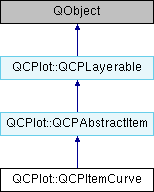 |
.Simulation
|
 |
.Simulation
|
A curved line from one point to another. More...

Public Member Functions | |
| QCPItemCurve (QCustomPlot *parentPlot) | |
| Creates a curve item and sets default values. More... | |
| QPen | pen () const |
| QPen | selectedPen () const |
| QCPLineEnding | head () const |
| QCPLineEnding | tail () const |
| void | setPen (const QPen &pen) |
| Sets the pen that will be used to draw the line. More... | |
| void | setSelectedPen (const QPen &pen) |
| Sets the pen that will be used to draw the line when selected. More... | |
| void | setHead (const QCPLineEnding &head) |
| Sets the line ending style of the head. More... | |
| void | setTail (const QCPLineEnding &tail) |
| Sets the line ending style of the tail. More... | |
| virtual double | selectTest (const QPointF &pos) const |
| This function is used to decide whether a click hits an item or not. More... | |
 Public Member Functions inherited from QCPlot::QCPAbstractItem Public Member Functions inherited from QCPlot::QCPAbstractItem | |
| QCPAbstractItem (QCustomPlot *parentPlot) | |
| Base class constructor which initializes base class members. | |
| bool | clipToAxisRect () const |
| QCPAxis * | clipKeyAxis () const |
| QCPAxis * | clipValueAxis () const |
| bool | selectable () const |
| bool | selected () const |
| void | setClipToAxisRect (bool clip) |
| Sets whether the item shall be clipped to the axis rect or whether it shall be visible on the entire QCustomPlot. More... | |
| void | setClipAxes (QCPAxis *keyAxis, QCPAxis *valueAxis) |
| Sets both clip axes. More... | |
| void | setClipKeyAxis (QCPAxis *axis) |
| Sets the clip key axis. More... | |
| void | setClipValueAxis (QCPAxis *axis) |
| Sets the clip value axis. More... | |
| void | setSelectable (bool selectable) |
| Sets whether the user can (de-)select this item by clicking on the QCustomPlot surface. More... | |
| void | setSelected (bool selected) |
| Sets whether this item is selected or not. More... | |
| QList< QCPItemPosition * > | positions () const |
| Returns all positions of the item in a list. More... | |
| QList< QCPItemAnchor * > | anchors () const |
| Returns all anchors of the item in a list. More... | |
| QCPItemPosition * | position (const QString &name) const |
| Returns the QCPItemPosition with the specified name. More... | |
| QCPItemAnchor * | anchor (const QString &name) const |
| Returns the QCPItemAnchor with the specified name. More... | |
| bool | hasAnchor (const QString &name) const |
| Returns whether this item has an anchor with the specified name. More... | |
 Public Member Functions inherited from QCPlot::QCPLayerable Public Member Functions inherited from QCPlot::QCPLayerable | |
| QCPLayerable (QCustomPlot *parentPlot) | |
| Creates a new QCPLayerable instance. More... | |
| bool | visible () const |
| QCustomPlot * | parentPlot () const |
| QCPLayer * | layer () const |
| bool | antialiased () const |
| void | setVisible (bool on) |
| Sets the visibility of this layerable object. More... | |
| bool | setLayer (QCPLayer *layer) |
| Sets the layer of this layerable object. More... | |
| bool | setLayer (const QString &layerName) |
| This is an overloaded member function, provided for convenience. It differs from the above function only in what argument(s) it accepts. Sets the layer of this layerable object by name. More... | |
| void | setAntialiased (bool enabled) |
| Sets whether this object will be drawn antialiased or not. More... | |
Public Attributes | |
| QCPItemPosition *const | start |
| QCPItemPosition *const | startDir |
| QCPItemPosition *const | endDir |
| QCPItemPosition *const | end |
Protected Member Functions | |
| virtual void | draw (QCPPainter *painter) |
| QPen | mainPen () const |
 Protected Member Functions inherited from QCPlot::QCPAbstractItem Protected Member Functions inherited from QCPlot::QCPAbstractItem | |
| virtual QRect | clipRect () const |
| virtual void | applyDefaultAntialiasingHint (QCPPainter *painter) const |
| double | distSqrToLine (const QPointF &start, const QPointF &end, const QPointF &point) const |
| double | rectSelectTest (const QRectF &rect, const QPointF &pos, bool filledRect) const |
| virtual QPointF | anchorPixelPoint (int anchorId) const |
| QCPItemPosition * | createPosition (const QString &name) |
| QCPItemAnchor * | createAnchor (const QString &name, int anchorId) |
 Protected Member Functions inherited from QCPlot::QCPLayerable Protected Member Functions inherited from QCPlot::QCPLayerable | |
| bool | moveToLayer (QCPLayer *layer, bool prepend) |
| void | applyAntialiasingHint (QCPPainter *painter, bool localAntialiased, QCP::AntialiasedElement overrideElement) const |
Protected Attributes | |
| QPen | mPen |
| QPen | mSelectedPen |
| QCPLineEnding | mHead |
| QCPLineEnding | mTail |
 Protected Attributes inherited from QCPlot::QCPAbstractItem Protected Attributes inherited from QCPlot::QCPAbstractItem | |
| bool | mClipToAxisRect |
| QCPAxis * | mClipKeyAxis |
| QCPAxis * | mClipValueAxis |
| bool | mSelectable |
| bool | mSelected |
| QList< QCPItemPosition * > | mPositions |
| QList< QCPItemAnchor * > | mAnchors |
 Protected Attributes inherited from QCPlot::QCPLayerable Protected Attributes inherited from QCPlot::QCPLayerable | |
| bool | mVisible |
| QCustomPlot * | mParentPlot |
| QCPLayer * | mLayer |
| bool | mAntialiased |
Additional Inherited Members | |
 Signals inherited from QCPlot::QCPAbstractItem Signals inherited from QCPlot::QCPAbstractItem | |
| void | selectionChanged (bool selected) |
| This signal is emitted when the selection state of this item has changed, either by user interaction or by a direct call to setSelected. | |
A curved line from one point to another.

It has four positions, start and end, which define the end points of the line, and two control points which define the direction the line exits from the start and the direction from which it approaches the end: startDir and endDir.
With setHead and setTail you may set different line ending styles, e.g. to create an arrow.
Often it is desirable for the control points to stay at fixed relative positions to the start/end point. This can be achieved by setting the parent anchor e.g. of startDir simply to start, and then specify the desired pixel offset with QCPItemPosition::setCoords on startDir.
| QCPlot::QCPItemCurve::QCPItemCurve | ( | QCustomPlot * | parentPlot | ) |
Creates a curve item and sets default values.
The constructed item can be added to the plot with QCustomPlot::addItem.
|
virtual |
This function is used to decide whether a click hits an item or not.
pos is a point in pixel coordinates on the QCustomPlot surface. This function returns the shortest pixel distance of this point to the item. If the item is either invisible or the distance couldn't be determined, -1.0 is returned. setSelectable has no influence on the return value of this function.
If the item is represented not by single lines but by an area like QCPItemRect or QCPItemText, a click inside the area returns a constant value greater zero (typically 99% of the selectionTolerance of the parent QCustomPlot). If the click lies outside the area, this function returns -1.0.
Providing a constant value for area objects allows selecting line objects even when they are obscured by such area objects, by clicking close to the lines (i.e. closer than 0.99*selectionTolerance).
The actual setting of the selection state is not done by this function. This is handled by the parent QCustomPlot when the mouseReleaseEvent occurs.
Implements QCPlot::QCPAbstractItem.
| void QCPlot::QCPItemCurve::setHead | ( | const QCPLineEnding & | head | ) |
Sets the line ending style of the head.
The head corresponds to the end position.
Note that due to the overloaded QCPLineEnding constructor, you may directly specify a QCPLineEnding::EndingStyle here, e.g.
| void QCPlot::QCPItemCurve::setPen | ( | const QPen & | pen | ) |
Sets the pen that will be used to draw the line.
| void QCPlot::QCPItemCurve::setSelectedPen | ( | const QPen & | pen | ) |
Sets the pen that will be used to draw the line when selected.
| void QCPlot::QCPItemCurve::setTail | ( | const QCPLineEnding & | tail | ) |
Sets the line ending style of the tail.
The tail corresponds to the start position.
Note that due to the overloaded QCPLineEnding constructor, you may directly specify a QCPLineEnding::EndingStyle here, e.g.
 1.8.5
1.8.5